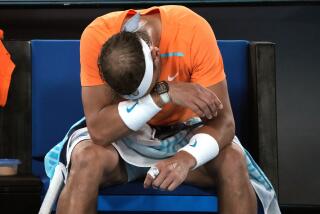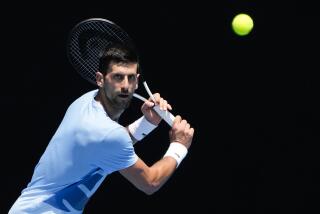Kuerten Makes a Quick Exit
- Share via
MELBOURNE, Australia — Where have all the sambas gone?
Maybe the Brazilians knew something and stayed home en masse, leaving Gustavo Kuerten on his own. Rarely has Kuerten played under quieter circumstances than Monday at the Australian Open. The roof of Rod Laver Arena was closed for his match because of inclement weather and sounded like a tomb, and there appeared to be just one Brazilian flag in the upper deck.
Frankly, there would not have been much for them to cheer after the first two sets. France’s Julien Boutter pulled off the biggest upset of the opening day, defeating the second-seeded Kuerten, 3-6, 4-6, 7-5, 6-3, 6-3, in 3 hours 9 minutes.
Boutter hit an impressive array of shots--37 aces and 91 winners.
Kuerten, who has often dealt with back and groin injuries, needed treatment from the trainer in the fifth set. His loss, combined with the injury withdrawal of Andre Agassi, means the tournament has lost its second- and third-seeded men.
Injuries also impacted the women’s draw. Fifth-seeded Serena Williams pulled out because of an injured right ankle, and former champion and wild-card entrant Mary Pierce of France withdrew because of an abdominal strain after dropping the first four games to Jill Craybas.
In early action, two seeded players lost on the women’s side in the first round--Nathalie Dechy of France defeated No. 9 Sandrine Testud of France, 7-5, 4-6, 6-3, and Mariana Diaz-Oliva of Argentina beat No. 26 Cristina Torrens-Valero of Spain, 7-5, 6-4.
By late afternoon, the sun emerged, brightly, and the roof opened again for No. 2 Venus Williams’ first-round match against 20-year-old qualifier Ansley Cargill. Williams defeated the 230th-ranked Cargill, 6-2, 6-2, in 50 minutes. Williams, who needed three sets against a qualifier here last year in the first round, had only four aces but hit 32 winners to Cargill’s two.
Also showing impressive form was four-time champion and No. 8 Monica Seles, who defeated Patty Schnyder of Switzerland, 6-1, 6-2.
Williams did not get on the court until late in the afternoon because of rain delays and the length of Kuerten’s match. About the only person outside of Kuerten’s entourage who thought he could do something here was hopeful tournament director Paul McNamee.
Kuerten, though, has never gone past the second round here. The local oddsmakers put Kuerten’s chances at 20-1 and he didn’t exactly approach this event with conviction, playing no tune-up matches in preparation.
Boutter, on the other hand, actually put in some warm-up work, reaching the quarterfinals at a Sydney tournament. Greg Rusedski, who lost to Boutter last year in Milan, predicted on Saturday that Boutter would make it difficult for Kuerten. Also, Boutter knows how to play Kuerten, having beaten him indoors at Basel, Switzerland, in October.
For Boutter, the unusual rain delays were fortuitous. “I like playing indoors,” he said.
His coach scolded him after the first rain delay, telling him he was not playing his own stylistic attacking game.
“I was trying to put pressure on him, but not so often,” Boutter said. “When we started again, I tried to, but nothing was coming as I wanted. After, I chose another, looser racket, and I started to put the ball in, feel my game again, playing some good volleys. All the pieces were getting together. After that, everything seems too easy; of course, he was injured.”
An injured Kuerten can often be dangerous. The appearance of a trainer is not always a good sign for his opponents. Afterward, Kuerten was not immediately available for comment, leaving the grounds for off-site medical treatment.
“It’s not easy because you know the person isn’t 100%. It’s pretty hard to keep your concentration,” Boutter said.
By the fourth set, Boutter started to control his destiny and it was obvious Kuerten would be on his way home, and if anything, his fans were the smart ones, wisely saving their money for the French Open.
More to Read
Go beyond the scoreboard
Get the latest on L.A.'s teams in the daily Sports Report newsletter.
You may occasionally receive promotional content from the Los Angeles Times.











